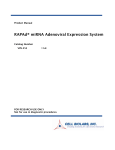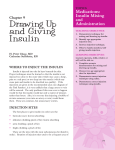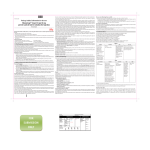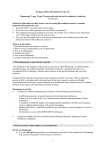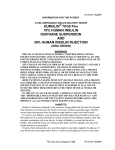Download Human Adiponectin ELISA Kit User Manual - Zen
Transcript
Zen-Bio, Inc. B-Bridge International, Inc. Human Adiponectin ELISA Kit User Manual ZBM0006.00 UM-100101 Published 01 October 2002 Catalog# ADIP-1 and ADIP-2 Human Adiponectin ELISA Kit User Manual See List of Components for Storage Conditions FOR RESEARCH USE ONLY Rev. 12/04 Mouse Anti-Human Adiponectin Monoclonal Ab Coated Plate Sample Pre-Treatment Table of Contents Wash (350 L x 1) Standards and Pre-Treated Samples 100 L I. Introduction and Protocol Overview II. List of Components 1st Reaction:20-30C, 60min III. Additional Materials Required IV. Reagent Preparation and Storage Wash (350 L x 3) V. Adipocyte Treatment VI. Sample Pre-Treatment VII. Human Adiponectin ELISAAnti-Adiponectin Protocol Secondary Rabbit Ab 100 L VIII. Calculation of Results IX. Troubleshooting Guide and FAQs 2nd Reaction:20-30C, 60min X.Prepare References Detection Ab Solution Wash (350 L x 3) Detection Ab Solution Prepare Substrate Solution 100 L 3rd Reaction:20-30C, 60min Wash (350 L x 3) 100 L Substrate Solution Notice to Purchaser 3 5 6 7 8 9 10 12 13 19 Color Development:20-30C, 15min This product is for research use only. It is not intended for human, veterinary, or in vitro diagnostic use. Proper precautions and biological containment should be taken when handling 100 L Stop Solution cells of human origin, due to their potential biohazardous nature. Always wear gloves and work behind a protective screen when handling primary human cells. All media, supplements, and tissue culture ware used in this protocol should be sterile. Zen-Bio and B-Bridge products may Absorbance at 450nm not be resold, modified Read for resale, or used to manufacture commercial products without the express written consent of Zen-Bio, Inc and B-Bridge International, Inc. 2002, B-Bridge International, Inc. All Rights Reserved. 2002, Zen-Bio, Inc. All Rights Reserved. B-Bridge International, Inc. Zen-Bio, Inc 2 www.b-bridge.com www.zen-bio.com Human Adiponectin ELISA Kit User Manual I. Introduction and Protocol Overview Obesity, and obesity-related disorders, are reaching alarming proportions in the US, and are on the increase in Europe and Asia. A deeper understanding of the molecular and cellular dynamics of such disorders, and their subsequent amelioration, will have a far-reaching impact on the quality of life of millions of people worldwide. Adipocytes (fat cells) express a variety of proteins that function in the homeostatic control of glucose and lipid metabolism. Insulin regulates the translocation and secretion of many of these proteins in response to changes in energy balance. Adipocyte complement-related protein of 30 kDa (Acrp30), now known as adiponectin, is a protein whose secretion from adipocytes is enhanced by insulin stimulation. It has been suggested that the development of non-insulin dependent (Type II) diabetes may involve dysregulation of adiponectin secretion (1). In support of the link between obesity and Type II diabetes, it has been shown that decreased expression of adiponectin correlates with insulin resistance (2,3), and that adiponectin appears to be a potent insulin enhancer linking adipose tissue and whole-body glucose metabolism (4). This Human Adiponectin ELISA Kit is designed to measure the concentration of human adiponectin from human serum/plasma, human adipocytes, or conditioned medium. The principle of the assay is shown in Figure 1. Pre-treated samples and serially diluted standard (recombinant human adiponectin) solutions are added to an appropriate number of wells of the microtiter plate and incubated. Adiponectin in the sample will be bound by the primary anti-adiponectin monoclonal antibody immobilized in the well (1st Reaction). After washing, the secondary rabbit anti-adiponectin antibody is added to each well and allowed to incubate (2nd Reaction). The secondary rabbit anti-adiponectin polyclonal antibody will bind to the adiponectin trapped in the well in the 1 st Reaction. After washing, a conjugate of horseradish peroxidase and goat anti-rabbit IgG is added to each well and allowed to incubate (3rd Reaction). The detection antibody will recognize and bind to the rabbit anti-adiponectin antibody trapped in the well in the 2nd Reaction. After washing, the colorimetric substrate for the enzyme is added to all wells and incubated. The color development is terminated by the addition of a stop solution. The intensity of the color is measured at 450 nm. The concentrations of the samples tested are calculated using the absorbance values of the adiponectin standard solutions assayed at the same time. B-Bridge International, Inc. Zen-Bio, Inc 3 www.b-bridge.com www.zen-bio.com Human Adiponectin ELISA Kit User Manual Figure 1. Adiponectin Rabbit anti-Adiponectin antibody HRP-conjugated goat anti-rabbit IgG E ◆ ◆ ◆ ◆ Assay Principle E E ○ ○ ○ ○ ○ YY Y YY 3rd Reaction 2nd Reaction 1st Reaction Substrate Color Development ○ ○ ○ E Y Y Y ◆ ◆ ◆ ◆ Y Y Y E E Y Y Y Y Y Y ◆ ◆ ◆ ◆ ◆ ● ● E Y Y Y ◆ Y Y Y E Y Y Y ◆ Y Y Y E ● ◆ Anti-Adiponectin monoclonal antibody coated plate B-Bridge International, Inc. Zen-Bio, Inc 4 www.b-bridge.com www.zen-bio.com Human Adiponectin ELISA Kit User Manual II. List of Components Store components 1-13 at 2-8C. DO NOT FREEZE. Store component 14 in a humidified CO2 incubator at 37C, 5% CO2. 1 25X WASH SOLUTION 1 Bottle (40mL) 2 SAMPLE PRE-TREATMENT SOLUTION 1 Bottle (10mL) 3 5X SAMPLE DILUENT . PRIMARY ANTIBODY-COATED PLATE One plate holds 12x8-well strips (96 wells), with adsorbed mouse anti-human adiponectin monoclonal antibody. Plate is provided in a resealable foil pouch with desiccant. 1 Bottle (50mL) 5 ADIPONECTIN STANDARD Recombinant human adiponectin (12.0 ng/mL) 1 Vial (2mL) 6 SECONDARY ANTIBODY SOLUTION Rabbit anti-human adiponectin polyclonal antibody 1 Bottle (12mL) 7 DETECTION ANTIBODY CONCENTRATE Horseradish peroxidase (HRP)-conjugated goat anti-rabbit IgG 1 Vial (0.1mL) 8 DETECTION ANTIBODY DILUENT 1 Bottle (15mL) 9 SUBSTRATE A 1 Bottle (7.5mL) 10 SUBSTRATE B 1 Bottle (7.5mL) 11 STOP SOLUTION 1 Bottle (15mL) 4 1 Plate Components 12-15 for ADIP-2 kit only 12 ZEN-BIO PPAR AGONIST 1 vial (500μl) 13 BASAL MEDIUM (BM-1) 1 Bottle (30mL) 14 ADIPOCYTE MEDIUM (AM-1) 1 Bottle (50ml) 15 HUMAN SUBCUTANEOUS ADIPOCYTES 96 well plate PLATE SEALERS Six sealers per package 1 Package MSDS forms are available on our website—please visit www.b-bridge.com B-Bridge International, Inc. Zen-Bio, Inc 5 www.b-bridge.com www.zen-bio.com Human Adiponectin ELISA Kit User Manual III. Additional Materials Required The following materials are required, but not supplied: Graduated cylinder Micropipettor(s) and disposable pipette tips Null strips for 96-well plate 96-well plate or manual strip washer Paper towels or absorbent paper Plate reader capable of measuring absorbance at a wavelength of 450nm (reference filter at 650 nm, optional) Heat block or equivalent Well-closed containers such as microtubes (1.5 mL or more in capacity) or 96 well plate that fits into a 96 well plate heat block and can withstand temperatures up to 100ºC. B-Bridge International, Inc. Zen-Bio, Inc 6 www.b-bridge.com www.zen-bio.com Human Adiponectin ELISA Kit User Manual IV. Reagent Preparation and Storage 1. 1X Wash Solution Prepare 1X Wash Solution by mixing all of the 25X Wash Solution (40mL) with 960 mL of deionized water or equivalent. If crystals are observed in the 25X Wash Solution bottle, warm the bottle in a 37°C water bath until the crystals disappear. After preparation, store 1X Wash Solution at 2-8°C. 2. 1X Sample Diluent Prepare 1X Sample Diluent by mixing all of the 5X Sample Diluent (50mL) with 200mL of deionized water or equivalent. After preparation, store 1X Sample Diluent at 2-8°C. 3. Adiponectin Standard Solution Prepare each Adiponectin Standard (6.0 ng/mL, 3.0 ng/mL, 1.5 ng/mL, 0.75 ng/mL,0.375 ng/mL) by serially diluting the supplied adiponectin standard solution (12.0 ng/mL) with 1X Sample Diluent . Use undiluted adiponectin (12.0 ng/mL) and 1X Sample Diluent for 12.0 ng/mL and 0 ng/mL standard solutions, respectively. 4. Detection Antibody Solution Prepare the Detection Antibody Solution by adding one part Detection Antibody Concentrate to 200 parts Detection Antibody Diluent. Prepare only as much Detection Antibody Solution as needed. 5. Substrate Solution Prepare the Substrate Solution by adding one part Substrate A to one part Substrate B. Prepare only as much Substrate Solution as needed. Return Substrate A to 2-8°C immediately after the necessary volume is removed. Next step is for treating samples from human cultured adipocytes only (kit catalog # ADIP-2) 6. Sample Pre-Treatment Solution Dilute sample pre-treatment solution as follows. Remove 2 ml sample pre-treatment solution to clean conical tube. Add 8 ml diH20. Invert to mix. Prepare samples for pre-treatment in this solution. Note: Do not mix reagents from different kits unless they have the same lot number. B-Bridge International, Inc. Zen-Bio, Inc 7 www.b-bridge.com www.zen-bio.com Human Adiponectin ELISA Kit User Manual V. Adipocyte Treatments (applies only to ADIP-2 kit) This kit contains one 96 well plate of cultured human subcutaneous adipocytes. We recommend using no more than 84 wells for all treatments and controls in order to leave room on the ELISA plate for the standard curve (duplicate wells). We recommend the following procedure for treatment of the adipocytes: On the day the cells arrive: 1. Check the seal for each plate. Please be aware that these cells are of human origin. Please treat them as potentially infectious since we cannot test for all pathogens. ALWAYS WEAR GLOVES AND USE PROTECTIVE MEASURES WHEN HANDLING HUMAN PRIMARY CELLS. 2. Place the package into a sterile environment. THIS IS VERY IMPORTANT SINCE BREAKING THE VACUUM SEAL MAY POTENTIALLY INTRODUCE CONTAMINATION INTO THE PLATE. Use scissors to snip open the bag at any end. The vacuum seal should be released at this time. You may notice some bubbling of the media in the plate at this time. This is normal and will not affect cell performance. 3. In a sterile environment, remove the plate from the bag, taking care to not disturb the cover top from the plate. Open the lid and remove the white liner using sterile forceps or a hemostat and discard. Carefully remove the clear adhesive seal by grabbing the edge with sterile forceps or hemostat and lifting the film slowly towards the other end. Discard adhesive film in appropriate biohazard waste container. Replace lid on plate. 4. Warm the BM-1 included with the cells to 37ºC in a water bath. 5. When the medium is warm remove 250 µl of the medium from all wells of the plate and replace with 150 µl BM-1. 6. Remove 150 µl of the medium and replace with a fresh 150 µl aliquot of BM-1. This process removes all serum and hormone from the cells. 7. Place cells in a 37ºC humidified incubator at 5% CO2. Allow cells to rest for 3 days. On the day of the assay: 1. Prepare all treatments in AM-1. 500 µL PPAR agonist in AM-1 has been provided with this kit and is ready for use. 2. Remove medium from treatment wells and replace with appropriate treatment medium. 3. Zen-Bio recommends treating in triplicate wells. 4. No more than 89 of the wells can be used for treatment to allow room on the ELISA plate for the standard curve. 5. After plate is treated place cells in a 37ºC humidified incubator at 5% CO2. Suggested treatment time is 72 hours. 6. At the end of the treatment period prepare the samples as described in section VI. B-Bridge International, Inc. Zen-Bio, Inc 8 www.b-bridge.com www.zen-bio.com Human Adiponectin ELISA Kit User Manual VI. Sample Pre-Treatment Human Serum or Plasma Samples 1. Allow all the reagents needed for sample pre-treatment, including serum or plasma (EDTA- or heparin-containing), to come to room temperature (20-30°C) prior to the start of the sample pre-treatment. 2. Mix 10 L of serum or plasma samples with 90 L of Sample Pre-treatment Solution and heat the mixture for 5 minutes at 100°C using a heat block. To heat the samples, use well-closed containers (1.5 mL or more in capacity) such as microtubes. NOTE: Make sure to eliminate the precipitate in the Sample Pre-treatment Solution by warming to 37ºC. 3. Add 900 L of 1X Sample Diluent to each container after heating (1:100 diluted samples at final volume). 4. Transfer 20 L of each diluted sample to a clean container and then add 1.0 mL of 1X Sample Diluent to the container (1:5100 dilution at final volume). Repeat for each sample. Human Adipocyte Cellular Extracts or Conditioned Media From Human Adipocytes (ADIP-2 kit) 1. Allow all the reagents needed for sample pre-treatment, including cellular extracts or conditioned media, to come to room temperature (20-30°C) prior to the start of the sample pre-treatment. 2. Mix 20 L of the adipocyte cellular extract or conditioned media with 80 L of Diluted Sample Pre-treatment Solution (see step 6 in Reagent Preparation and Storage on page 7), and heat the mixture for 5 minutes at 100°C using a heat block. To heat the samples, use well-closed containers (1.5 mL or more in capacity) such as microtubes. Alternatively, samples can be prepared in a 96 well plate suitable for PCR work and heated in a PCR machine or other multi-well plate warmers. 3. Add 400 L of 1X Sample Diluent to each container after heating (1:25 diluted samples at final volume). Alternatively, transfer 50 L of pretreated solution from step 2 to a new 96 well plate and add 200 L 1X Sample Diluent to each well. Pipet up and down gently to mix. B-Bridge International, Inc. Zen-Bio, Inc 9 www.b-bridge.com www.zen-bio.com Human Adiponectin ELISA Kit User Manual VII Human Adiponectin ELISA Protocol 1. Allow all reagents to come to room temperature (20-30°C) prior to the start of the assay. Prepare 1X Wash Solution, 1X Sample Diluent, and Adiponectin Standards according to Reagent Preparation (Steps 1, 2, and 3). 2. Remove Primary Antibody-Coated Plate from its foil pouch. Remove any unneeded strips from the plate frame, reseal them in the foil pouch, and return the foil pouch to 2-8°C. If a 96-well plate washer is used, the plate frame should be completely filled with wells by adding as many null strips as necessary. Identify well position(s) for each sample on a data sheet or plate map. 3. Fill the wells with 1X Wash Solution (~350 L) and immediately aspirate using a plate washer. If wells are washed manually, invert the plate(s) and gently tap on a clean absorbent towel. 4. Add 100 L of adiponectin standard or pre-treated sample to the appropriate number of antibody-coated wells. Every plate must include the standard series to properly correlate the sample readings. 5. Cover plate(s) securely with a plate sealer and incubate at 20-30°C for 60 minutes. 6. Wash the plate(s) as follows: a. At the end of the incubation, carefully remove the plate sealer, avoiding splashing, and discard appropriately. b. Completely aspirate the liquid from the wells using a plate washer. c. Fill each well with 1X Wash Solution (~350 L/well) and immediately aspirate. Avoid Wash Solution overflow. d. Repeat Step 6c two more times for a total of three washes. e. Invert the plate(s) and gently tap on a clean absorbent towel. 7. Dispense 100 L of the Secondary Antibody Solution into each well. 8. Cover plate(s) securely with a (new, clean) plate sealer and incubate at 20-30°C for 60 minutes. 9. Repeat the wash procedure described in step 6. Prepare Detection Antibody Solution according to Reagent Preparation (Step 4). 10. Dispense 100 L of Detection Antibody Solution into each well. 11. Cover plate(s) securely with a plate sealer and incubate at 20-30°C for 60 minutes. Prepare Substrate Solution according to Reagent Preparation (Step 5). 12. Repeat the wash procedure described in step 6. 13. Dispense 100 L of Substrate Solution into each well. 14. Incubate the plates at 20-30°C for 15 minutes. B-Bridge International, Inc. Zen-Bio, Inc 10 www.b-bridge.com www.zen-bio.com Human Adiponectin ELISA Kit User Manual VII Human Adiponectin ELISA Protocol continued 15. Dispense 100 L of Stop Solution into each well. 16. Read the plate at 450 nm using a plate reader. If using a dual filter instrument, the recommended reference wavelength is 650nm. Figure 2. Flow Chart of Assay Procedure Mouse Anti-Human Adiponectin Monoclonal Ab Coated Plate Sample Pre-Treatment Wash (350 L x 1) Standards and Pre-Treated Samples 100 L 1st Reaction:20-30C, 60min Wash (350 L x 3) Secondary Rabbit Anti-Adiponectin Ab Prepare Detection Ab Solution 2nd Reaction:20-30C, 60min Wash (350 L x 3) Detection Ab Solution Prepare Substrate Solution 100 L 100 L 3rd Reaction:20-30C, 60min Wash (350 L x 3) Substrate Solution 100 L Color Development:20-30C, 15min Stop Solution 100 L Read Absorbance at 450nm Reference at 650nm B-Bridge International, Inc. Zen-Bio, Inc 11 www.b-bridge.com www.zen-bio.com Human Adiponectin ELISA Kit User Manual VIII Calculation of Results 1. Subtract the mean absorbance value of the 0 ng/mL blank from each mean absorbance value of the standard series and samples tested (Net Absorbance). 2. Plot the concentrations of each standard and the calculated Net Absorbances on the X-axis and Y-axis, respectively. Fit an appropriate regression curve on the plots. 3. Determine the adiponectin concentrations of the samples by interpolation of the regression curve formula. 4. The adiponectin concentrations calculated must be multiplied by the appropriate dilution factor (x5100 for serum or plasma samples and x25 for adipocyte cellular extracts or conditioned medium) to obtain the correct result for undiluted samples. Figure 3. Typical Standard Curve Net-Absorbance 5 1 0.1 0.1 1 10 20 Concentration of Adiponectin B-Bridge International, Inc. Zen-Bio, Inc 12 www.b-bridge.com www.zen-bio.com Human Adiponectin ELISA Kit User Manual IX. Troubleshooting Guide and FAQs Troubleshooting Guide 1. Lack of signal or weak signal in all wells Possible explanations: 2. High signal and background in all wells Possible explanations: 3. Improper or inadequate washing; be certain that all wash volumes and repetitions were correct. Improper dilution of detection antibody. Overdeveloping; decrease the incubation time before the Stop Solution is added. High background in sample wells only Possible explanations: 4. Omission of a reagent or a step. Improper preparation or storage of a reagent. Assay performed before reagents were allowed to come to 20-30C. Plate reader did not perform well. Sample concentration was too high. Improper dilution of detection antibody. Weak signal in sample wells only Possible explanations: Sample concentration was too low. Improper dilution of detection antibody. FAQs (Frequently Asked Questions) 1. What is the shelf life of this kit? ADIP-1 Currently, all components of this kit have a shelf life of 9 months when stored at 2-8C. However, it is fully anticipated that this will be extended in the future. The expiration date appears on the top label of the product package. ADIP-2 Must be used within 1 week of arrival. 2. Can I pool reagents? Yes, as long as the reagents are from the same lot. 3. What is the effect of freezing/thawing the standard and samples? No significant effect was observed when adiponectin standards, untreated samples, pre-treated samples and diluted samples were frozen and thawed five times (Figure 4). B-Bridge International, Inc. Zen-Bio, Inc 13 www.b-bridge.com www.zen-bio.com Human Adiponectin ELISA Kit User Manual IX Troubleshooting Guide and FAQs continued Figure 4. Std (ng/mL) 12.000 6.000 3.000 1.500 0.750 0.375 0.000 Effects of Freeze/Thaw OD450nm-650nm NF F/T x3 F/T x5 2.235 2.220 2.181 1.495 1.429 1.385 0.902 0.848 0.839 0.487 0.472 0.460 0.266 0.262 0.253 0.153 0.154 0.148 0.025 0.025 0.025 Untreated No.31 No.34 No.35 Adiponectin (ng/mL) NF F/T x3 F/T x5 1.308 1.171 1.234 0.606 0.619 0.566 3.453 3.561 3.439 Diluted x5100 No.31 No.34 No.35 Adiponectin (ng/mL) NF F/T x3 F/T x5 1.308 1.326 1.346 0.606 0.691 0.708 3.453 3.703 3.664 Diluted x100 No.31 No.34 Adiponectin (ng/mL) NF F/T x3 F/T x5 0.882 0.889 0.866 0.508 0.505 0.519 NF = Not Frozen F/T = Freeze/Thaw 4. Does the method of separation of serum/plasma affect the measurement of adiponectin? There is no significant difference in measurements of adiponectin from separated serum samples. However, neither whole blood nor whole blood treated with citrate can be used. Samples from three healthy individuals were taken and serum/plasma were treated by several different methods, results shown below (Figure 5). Figure 5. Effects of Separation Method Serum Plasma Coagulated Coagulated + Sep'n Gel 3.234 1.941 1.275 3.422 2.157 1.289 Heparin 3.136 2.036 1.206 Citrate 2.766 1.539 0.990 EDTA (Na)2 3.304 1.744 1.127 (Adiponectin:ng/mL) B-Bridge International, Inc. Zen-Bio, Inc 14 www.b-bridge.com www.zen-bio.com Human Adiponectin ELISA Kit User Manual IX. Troubleshooting Guide and FAQs continued 5. At what temperature should samples be stored (both untreated and pre-treated)? Samples should be stored at -70C. 6. How stable are the samples at 4C and at room temperature (RT)? Untreated serum and pre-treated x5100 diluted serum can be stored at 4C for up to 7 days. Pre-treated x100 diluted serum, however, cannot be stored refrigerated without a significant decrease in detectable adiponectin (Figure 6). Figure 6. Measurement of Adiponectin After Storage at 4C No.35 1.20 7.00 1.00 6.00 0.80 Serum 0.60 ×100 0.40 ×5100 Adiponectin (ng/mL) Adiponectin (ng/mL) No.34 0.20 0.00 1 2 3 4 5.00 4.00 Serum 3.00 ×100 ×5100 2.00 1.00 0.00 5 1 2 Days at 4C 3 4 5 Days at 4C Untreated serum and pre-treated serum samples are stable for 8 hours at RT. Pre-treated x100 diluted serum samples cannot be stored at RT without a decrease in detectable Adiponectin (Figure 7). Therefore, samples should be diluted x5100 following pre-treatment and heating. Ideally, all samples should be stored at -70C. Figure 7. Measurement of Adiponectin After Storage at RT No.35 1.00 Adiponectin (ng/mL) Adiponectin (ng/mL) No.34 0.80 Serum 0.60 ×100 0.40 ×5100 0.20 0.00 0 1 2 3 4 5 6 7 8 9 5.00 4.00 Serum 3.00 ×100 ×5100 2.00 1.00 0.00 0 Hours at RT B-Bridge International, Inc. Zen-Bio, Inc 6.00 1 2 3 4 5 6 7 8 9 Hours at RT 15 www.b-bridge.com www.zen-bio.com Human Adiponectin ELISA Kit User Manual IX. Troubleshooting Guide and FAQs continued 7. What if I only heat the samples for 5 minutes in the pre-treatment incubation step? As shown in Figure 8 below, samples were heated at 100C in a heat block for 0 to 20 minutes, then the ELISA was performed and the samples were tested. For samples heated between 1 minute and 20 minutes, there was no significant difference in the adiponectin concentrations recorded. Figure 8. Sample No. 34 No. 35 0 0.083 0.270 Effects of Pre-Treatment Incubation Times Pre-Treatment Incubation Time (minutes) 1 3 5 7 10 0.985 0.918 0.901 0.931 0.899 5.192 5.443 5.104 5.202 4.405 20 0.976 4.744 (Adiponectin: ng/mL) 8. What temperature range can I use in the pre-treatment incubation step? When samples were heated for 5 minutes at 5C intervals from 80C to 100C, there was no significant difference in the adiponectin concentrations recorded (Figure 9). Figure 9. Sample No.34 No.35 Effects of Pre-Treatment Incubation Temperature Pre-Treatment Incubation Temp (°C) 80 85 90 95 100 1.057 1.047 1.044 1.122 1.040 5.830 5.655 5.870 6.145 5.814 (Adiponectin: ng/mL) 9. How reproducible are the results? Several experiments were performed to determine the reproducibility of data obtained using this kit. In one experiment, 8 control high and control low samples were assayed (i.e., 16 samples total on one plate, measured on a plate reader simultaneously), data shown in Figure 10 (first table). In the second table are the results of measuring single control high and low samples from the same ELISA 6 times consecutively (i.e., one sample of each measured on a plate reader 6 times in a row). The third table shows the results of eight assays (control high and low) run by four different people. B-Bridge International, Inc. Zen-Bio, Inc 16 www.b-bridge.com www.zen-bio.com Human Adiponectin ELISA Kit User Manual IX. Troubleshooting Guide and FAQs continued Figure 10. Reproducibility 8 Samples From Same Plate Measured Simultaneously test-1 test-2 test-3 test-4 test-5 test-6 test-7 test-8 mean SD Control High 2.648 2.722 2.746 2.715 2.51 2.831 2.759 2.783 2.714 0.098 Control Low 0.717 0.714 0.706 0.752 0.706 0.739 0.684 0.687 0.713 0.023 2 Samples Measured 6 Times Consecutively test-1 test-2 test-3 test-4 test-5 test-6 mean SD CV (%) Control High 2.714 2.803 2.934 3.203 3.001 2.921 2.929 0.169 5.8 Control Low 0.713 0.699 0.776 0.737 0.786 0.731 0.740 0.034 4.6 8 Assays by 4 Different People test-1 test-2 test-3 test-4 mean SD CV (%) Control High 2.829 3.016 2.872 3.001 2.930 0.0931 3.2 Control Low 0.780 0.698 0.835 0.786 0.775 0.0568 7.3 (Adiponectin: ng/mL) 10. What is the range of adiponectin that can be detected by this kit? We have established a minimum detectable limit as 23.4 pg/mL of adiponectin (unpublished data). The ELISA is linear within the range of 0.375 ng/mL to 12.0 ng/mL. 11. What will the effect be if I dilute my samples beyond what is recommended? Three serum samples were pre-treated as described in the protocol, resulting in a final dilution of x5100 (labeled in the table below as dilution “1”). The samples were then further diluted x2 and x4. The data are linear (Figure 11). Figure 11. Effects of Dilution 6 Adiponectin (ng/mL) 5 Adiponectin (ng/mL) Dil’n 1 1/2 1/4 No.7 2.309 1.128 0.552 No.21 4.985 2.692 1.284 No.22 0.943 0.453 0.239 4 No.21 3 No.7 2 No.22 1 0 1/4 1/2 1 Dilution B-Bridge International, Inc. Zen-Bio, Inc 17 www.b-bridge.com www.zen-bio.com Human Adiponectin ELISA Kit User Manual IX. Troubleshooting Guide and FAQs continued 12. Will the mouse anti-human adiponectin monoclonal Ab detect adiponectin from other species? Two experiments were conducted to examine the cross-reactivity of the anti-human monoclonal Ab. In the first, recombinant mouse adiponectin samples from a concentration of 0.313 to 320 ng/mL were assayed (see left table in Figure 12 below). In the second experiment, sera from different animals were pre-treated according to protocol and assayed (right table below). The results from the adiponectin standards run simultaneously are shown in the bottom table of Figure 12. There was no cross-reactivity observed. Figure 12. Recombinant Mouse Adiponectin [Antigen] ng/mL OD450-650nm Mean Absorbance 0.023 320 0.023 0.000 0.022 0.022 160 0.022 0.000 0.021 0.021 80 0.022 0.000 0.022 0.023 40 0.022 0.000 0.021 0.022 20 0.022 0.000 0.021 0.023 10 0.022 0.000 0.020 0.023 5 0.022 0.000 0.021 0.023 2.5 0.022 0.000 0.021 0.022 1.25 0.023 0.000 0.023 0.020 0.625 0.021 0.000 0.022 0.021 0.313 0.021 0.000 0.021 0.024 0 0.023 0.021 B-Bridge International, Inc. Zen-Bio, Inc Cross-Reactivity Pre-Treated Sera From Different Species OD450-650nm Mean Absorbance Species 0.025 Mouse 0.027 0.000 0.028 0.028 Rat 0.033 0.003 0.037 0.032 Goat 0.035 0.005 0.037 0.037 Sheep 0.039 0.009 0.04 0.021 Porcine 0.024 0.000 0.027 0.028 Calf 0.032 0.002 0.036 0.025 FBS 0.029 0.000 0.033 0.026 (Blank) 0.030 0.033 Recombinant Human Adiponectin [Antigen] ng/mL OD450-650nm Mean Absorbance 2.562 12.000 2.547 2.524 2.532 1.763 6.000 1.746 1.723 1.729 1.070 3.000 1.105 1.082 1.140 0.647 1.500 0.657 0.634 0.667 0.370 0.750 0.365 0.342 0.360 0.212 0.375 0.206 0.183 0.199 0.024 0 0.023 0.021 18 www.b-bridge.com www.zen-bio.com Human Adiponectin ELISA Kit User Manual X. References 1. Nemet, D., et al. (2002) Relationships among adiponectin and other adipose cytokines, body composition, and fasting insulin in lower socioeconomic middle school children. American Physiological Society’s (APS) Abstracts. 2. Yamauchi T., et al. (2001) The fat-derived hormone adiponectin reverses insulin resistance associated with both lipoatrophy and obesity. Nature Medicine, Aug; 7(8): 941-6 3. Kubota, N., et al. (2002) Disruption of adiponectin causes insulin resistance and neointimal formation. J Biol Chem. 277(29): 25863-6 (Epub 2002 May 24). 4. Berg A.H., et al. (2001) The adipocyte-secreted protein Acrp30 enhances hepatic insulin action. Nature Medicine, Aug; 7(8): 947-53 EXCEPT AS OTHERWISE EXPRESSLY SET FORTH IN THIS USER MANUAL, ZEN-BIO AND B-BRIDGE DO NOT MAKE ANY REPRESENTATION OR WARRANTIES OR CONDITIONS OF ANY KIND, EITHER EXPRESS OR IMPLIED, WITH RESPECT TO THE PRODUCTS, OR INFORMATION DISCLOSED HEREUNDER, INCLUDING, BUT NOT LIMITED TO, THE IMPLIED WARRANTIES OF MERCHANTABILITY, FIT FOR A PARTICULAR PURPOSE, OR NONINFRINGEMENT OF THE INTELLECTUAL PROPERTY RIGHTS OF THIRD PARTIES. Patent Pending. Manufactured by Otsuka Pharmaceuticals, Japan B-Bridge International, Inc. Zen-Bio, Inc 19 www.b-bridge.com www.zen-bio.com




















